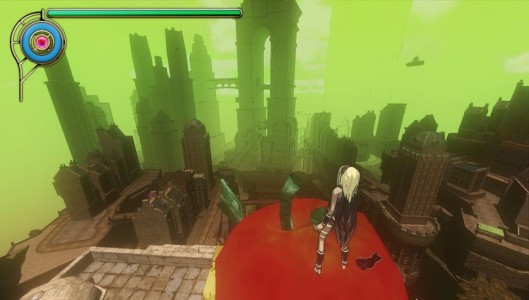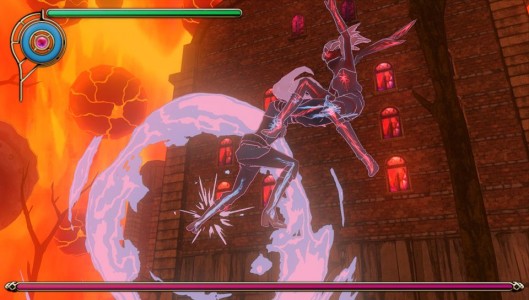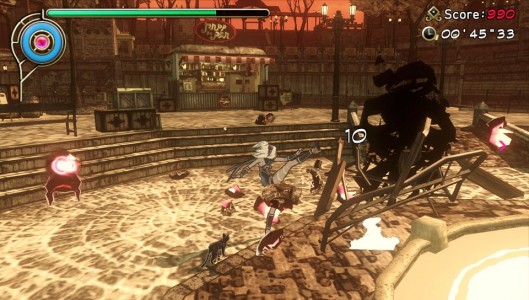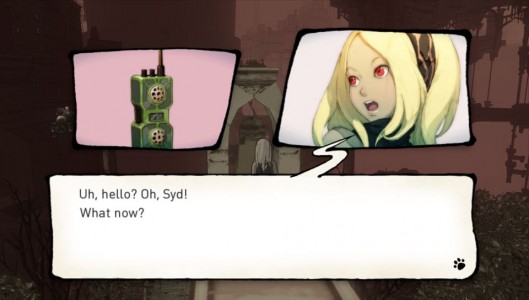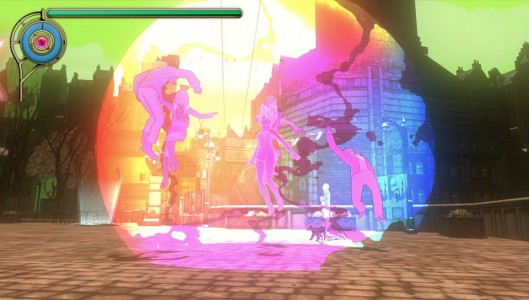Publisher: SCEA
Developer: SCE Japan Studio
Medium: Vita Card / Digital Download
Players: 1
Online: DLC
ESRB: T
From the first time we were given a glimpse of Gravity Rush for the PlayStation Vita, it was pretty obvious that it was going to be something special for future Vita owners. Is Gravity Rush perfect? Not quite. Is it a great game, and more importantly, a totally original title for the PS Vita worth your attention? Definitely.
Gravity Rush successfully mashes up open world gameplay, unique motion and touch controls and an incredibly attractive manga/graphic novel art style that plays and looks great on the PlayStation Vita. It doesn’t hurt that the story is well crafted and the characters are actually interesting as well.
In Gravity Rush, you play as Kat, a girl who, for whatever reason, loses her memory and gains gravity controlling power thanks to a mysterious black cat she befriends. The floating city that she finds herself in is in turmoil, with vast chunks of it and its citizens, missing thanks to severe gravity storms raging underneath. Even worse, some shadowy enemies known as the Nevi are causing chaos among the city and generally harassing the population still living there. After becoming accustomed to her new “shifter” powers and finding a place to live, Kat decides to chip in and see what she can do to help out.
The PlayStation Vita hardware is used to great effect in Gravity Rush, with the Sixaxis motion controls and touch screen used rather extensively. Kat is controlled primarily with the analog stick and buttons, for basic movements and attacks, but once she enables her shifting powers, the additional functionality comes into play. When in shift mode, Kat can hover and “fall” in any direction in the world. She can just fly around or land on and navigate along any surface in the floating city, all while maintaining her ability to run, jump, attack, etc. In other words, she can run on walls and the ceiling, just as easily as the ground. Your view and perspective changes appropriately of course, and sometimes the only way to determine which direction Kat is falling in is by looking at her hair and clothing, which just so happens to follow the regular laws of gravity and point downwards.
It’s all a little mind-bending at first, but thanks to the way in which the city is designed, it’s not often that you’ll become totally discombobulated. A lot of the game will be spent shifted, although you only have a limited time to do so before draining your upgradeable gravity meter and (harmlessly) crashing to the ground. The meter only takes seconds to refill, so there won’t be much down time, so to speak. If you happen to gravity shift while other people are around, they’ll get caught up in your aura and will float along with you screaming with fear until they too come crashing down to earth. It makes for some pretty amusing moments and honestly never seems to get old.
Gravity Rush is an open world game, sort of. The city of Hekseville is not incredibly large, and the missions you can partake in are very clearly defined on a map with nav points, so you’ll never spend time wandering around the environment. Open up the map, tap a conversation, mission or story point, and follow the arrow to your destination. With all the gravity shifting going on in the game, thankfully there are almost always arrows and icons pointing you in the right direction, including enemy locations and weak spots, way points and other important points of interest. Gravity Rush is somewhat more linear than you might expect, and it’s totally possible to just go from story mission to story mission and ignore the rest.
Kat starts out not being quite accustomed to her abilities, and that is reflected in the game’s controls. Almost every aspect of her abilities, from simply hovering, to performing flying kicks, to pulling off super attacks, can be upgraded by collecting crystals scattered about the city, or earned by completing missions. Some of these crystals can also be donated to fix parts of the city, which in turn, opens up more chances to collect crystals and progress through the story. Completing side-missions also unlock optional challenge missions that have Kat racing around the area, or eliminating a number of Nevi as quickly as possible. These challenges all have leaderboards associated with them so you can compare your results with friends, which is a nice touch as always.
The missions in the game themselves are fairly unique and usually enjoyable. None take more than a minute or so, and range in variety from transporting objects using shifting powers, to finding lost citizens deep within a gravity storm. There is more than a few that task you with eliminating waves of Nevi that can be more difficult than expected, especially when facing a boss or a tricky combination of enemies while you are underpowered. At least 2 or 3 of these battles frustrated me due to the lack of a checkpoint and the pinpoint accuracy of certain powerful enemies while Kat was in an awkward shifted state. Those are not common, but they do exist.
Overall, Gravity Rush is neither super hard or all that long, and with a moderate amount of upgrades, it should take most gamers around 6 – 7 hours to get through the story, which seems about average these days. Beyond the relatively small number of challenges, and collecting crystals for ability upgrades, there really isn’t a ton to do in the game after the story ends. Sony does have a few DLC packs in the works which should offer much more in the way of extra missions and whatnot when they become available in the near future. I would have liked more out of the box instead of needing to purchase content, but as most of us know, that’s the standard these days.
Visually, Gravity Rush is both stylish and gorgeous, with one of the best utilizations of cel shading techniques in recent memory. The city itself is detailed and purposefully dreary, but it’s the impressive lighting, shadows, color usage and animation that pull it all together. The animated graphic novel story scenes are also incredible, especially when you use the Vita’s motion sensing abilities to sort of shift the perspective to look around each cell.
The music in Gravity Rush should get a special mention since it’s not often that a developer opts for such a fun and jazzy soundtrack. I am also fully behind Sony’s decision to keep the made-up language voice work and just utilize subtitles. The writing is light and humorous throughout, and even during serious moments and scenarios, the game doesn’t take itself too seriously.
If you’re not sure about this whole gravity shifting business, especially after games that don’t quite get it right (Inversion for example), give the Gravity Rush demo a try at the very least. Gravity Rush is definitely recommended for PS Vita owners looking for a quality, original game.


